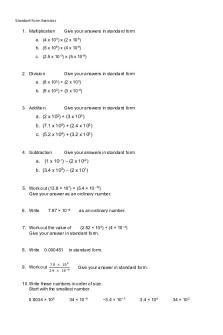Week 3- Preparation Activity- Rescorla-Wagner questions PDF

| Title | Week 3- Preparation Activity- Rescorla-Wagner questions |
|---|---|
| Course | Learning And Physiological Psychology |
| Institution | University of New South Wales |
| Pages | 3 |
| File Size | 98.7 KB |
| File Type | |
| Total Downloads | 12 |
| Total Views | 135 |
Summary
Practice questions...
Description
Rescorla Wagner Model Questions. In the following examples the letters refer to the following: T = tone L = light US = unconditioned stimulus The subscript letters following each letter refer to the intensity of the CS or US L = Low, M = Medium and H = high
Rescorla-Wagner model Please refer to the following design to answer the questions below: Group 1 2
Training Phase 1 TM- USM
Training Phase 2 LMTM-USM LMTM-USM
Testing LM LM
1. What phenomenon in classical conditioning is outlined in group 1? Compound conditioning - blocking
2. During test, how will responding to the light for Group 1 compare to Group 2? Group one there will be little or no learning, group 2 will be learning
3. How would the Rescorla-Wagner (1972) model account for these results? The associative strength would be weak for the light stimulus, therefore change in v would be lower than for the tone. Max associative strength has to split between in group 2, equal strength in group 2 Less learning allowed for light in group 1 The subject had prior learning with the tone in group 1, the light has less associative strength to the US. Whereas if they (light and tone) were introduced at the same time, they’d have equal associative strength.
4. According to the Rescorla-Wagner (1972) model, how much learning will accrue to the light and tone across Phase 2 training for group 1?
Light- 0 Tone-100
5. How could you increase the amount of learning about the light and the tone in Phase 2 training for group 1? Light should be presented with more intensity than the tone. – wouldn’t work much because there is little prediction error. Increase salience of US, therefore increase lambda – called unblocking
In the following hypothetical experiments, please indicate whether associative strength of the light will increase, decrease or stay the same from Phase 1 to Phase 2: Experiment 1 2 3 4 5 6
1.
Phase 1 LM- No US LM-USM TM-USM TM-USM TM-USM TM-USM, LM-USM
increase
acquisition
2.
decrease
extinction
3.
stay the same- very, very low learning if there is
blocking
4.
increase- increasing salience of US increases lambda
Unblocking – sort of acquisition
Phase 2 LM-USM LM-No US TMLM-USM TMLM-USH TMLM-No US TMLM-USM
5. decrease- light predicts that US won’t occur, light starts at zero and acquires negative strength Conditioned inhibition
6. decreaseoverexpectation...
Similar Free PDFs

WEEK 3 disc activity
- 2 Pages

Activity week 3 CP4P W3
- 2 Pages

Week 3 - Belbin Team Activity
- 2 Pages

Week 3 Differentiation Questions
- 2 Pages

Week 3 Homework Questions
- 3 Pages

Week 3 - vectors Questions
- 1 Pages

Tutorial Questions week 3
- 2 Pages

Week 3 questions. and answers
- 3 Pages

Tutorial 2 - Week 3 Questions
- 1 Pages

Standard Form Questions - Week 3
- 4 Pages

Week 3 Lab Review Questions
- 3 Pages
Popular Institutions
- Tinajero National High School - Annex
- Politeknik Caltex Riau
- Yokohama City University
- SGT University
- University of Al-Qadisiyah
- Divine Word College of Vigan
- Techniek College Rotterdam
- Universidade de Santiago
- Universiti Teknologi MARA Cawangan Johor Kampus Pasir Gudang
- Poltekkes Kemenkes Yogyakarta
- Baguio City National High School
- Colegio san marcos
- preparatoria uno
- Centro de Bachillerato Tecnológico Industrial y de Servicios No. 107
- Dalian Maritime University
- Quang Trung Secondary School
- Colegio Tecnológico en Informática
- Corporación Regional de Educación Superior
- Grupo CEDVA
- Dar Al Uloom University
- Centro de Estudios Preuniversitarios de la Universidad Nacional de Ingeniería
- 上智大学
- Aakash International School, Nuna Majara
- San Felipe Neri Catholic School
- Kang Chiao International School - New Taipei City
- Misamis Occidental National High School
- Institución Educativa Escuela Normal Juan Ladrilleros
- Kolehiyo ng Pantukan
- Batanes State College
- Instituto Continental
- Sekolah Menengah Kejuruan Kesehatan Kaltara (Tarakan)
- Colegio de La Inmaculada Concepcion - Cebu




